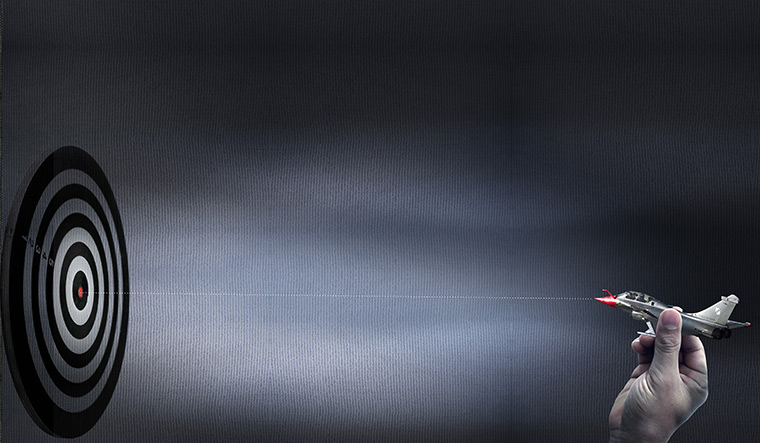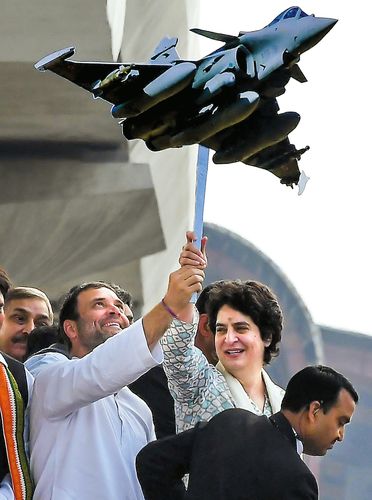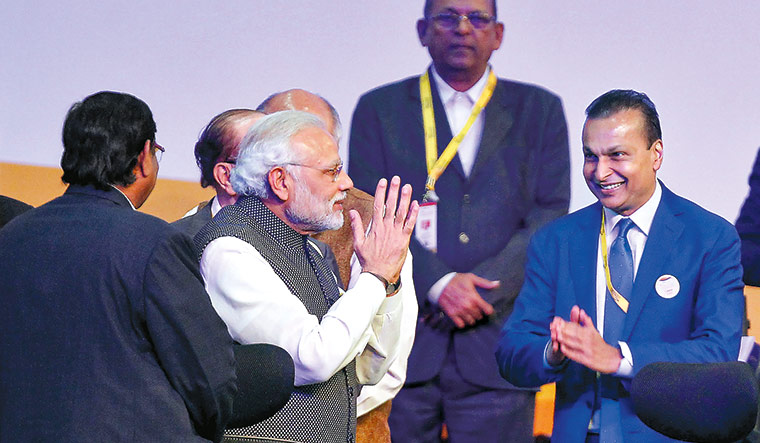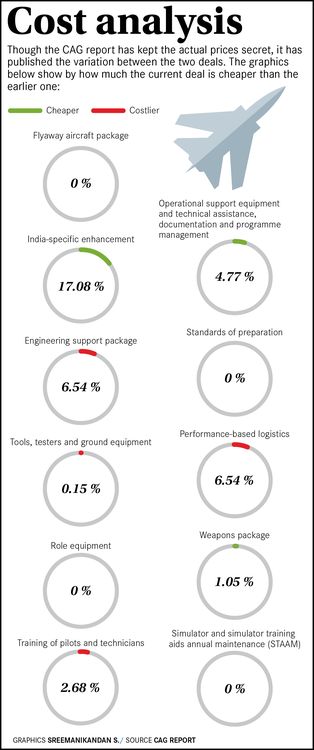Former defence minister Manohar Parrikar, who stayed back in Delhi when Prime Minister Narendra Modi went to Paris and announced a new Rafale deal, is now in an unenviable position. Objections over the manner in which the prime minister’s office was interfering in the negotiations headed by Air Marshal S.B.P. Sinha had been brought to his notice, and he is on record having downplayed them.
The latest bombshell has been the revelation that several officials in the negotiating team had objected to the prime minister’s office conducting parallel negotiations which, in their view, weakened India’s bargaining power over the French. Deputy secretary (air) S.K. Sharma even wrote in his note that the defence minister may advise “the PMO that any officers, who are not part of the... negotiating team may refrain from having parallel parlays [sic] (parleys) with the officers of the French government”.
When the objections were brought to Parrikar’s notice, he termed them an “over-reaction”, and said that “the PMO and the French president’s office are monitoring the progress of the issue which was an outcome of the summit meeting”. Yet, he recorded that the defence secretary may resolve the issue in consultation with the principal secretary to the prime minister. Meanwhile, chief negotiator Sinha (retired in December 2018), has jumped to the government’s defence. He has alleged that the opposition has been using the ministry note selectively.
But the critics are not satisfied. According to them, the government’s and negotiators’ defence still do not address the critical issue of the absence of a sovereign guarantee from the French government or a bank guarantee from the manufacturing company, Dassault Aviation. The government’s argument has been that India had been striking government-to-government deals with the Americans (under the US government’s Foreign Military Sales—FMS—programme) and the Russians without sovereign guarantees.
But as Sudhansu Mohanty, who was financial adviser to the defence ministry when the Rafale deal was signed, told THE WEEK, the deals with the Americans and the Russians have been pure government-to-government deals, whereas the Rafale deal was with Dassault—a private company. The French government has simply given a letter of comfort.
Normally, India has been insisting on sovereign guarantees when deals are made with private entities, and in case the host government is reluctant to give them, India has been seeking bank guarantees from the private company which can be encashed in case of failure of delivery. “Of the two, India has been preferring sovereign guarantees from host governments to bank guarantees from the supplier because bank guarantees add to the cost,” said a senior ministry official. “In this case, as I understand, neither was insisted on.” As Sharma wrote in his note, “This is contrary to the position taken by the MoD [ministry of defence] and conveyed by the Indian negotiating team that the commercial offer should be backed by sovereign guarantees or otherwise by bank guarantee.”
The government’s explanation is that a letter of comfort given by the French government is as good as a sovereign guarantee, and that the PMO went ahead with the deal on the assurance from none less than the French prime minister. Indeed, former French prime minister Manuel Valls wrote a letter on September 8, 2016, a fortnight before the intergovernmental agreement (IGA) was signed, saying that their government would fully back the obligations made by French firms in the contract.
Valls’s letter read: “In so far as the government of the Republic of India will be required to make down payments before the delivery of the aircraft and associated armaments, I hereby confirm that the government of the French Republic is fully committed in doing whatever is necessary to make sure that Dassault Aviation and [missile manufacturer] MBDA of France, each in their own respect, do their utmost to fully respect their obligations in accordance with aforesaid intergovernmental agreement and annexed supporting protocols.”
“Furthermore, assuming that Dassault Aviation or MBDA France meet difficulties in the execution, their respective supply protocols and would have to reimburse all or part of the intermediary payment to the government of India, the government of French Republic will take appropriate measures so as to make sure that said payment or reimbursement will be made at the earliest,” the letter stated.
Valls’s letter also said: “These commitments made by the French government as well as the mechanism stipulated in intergovernmental agreement will prevent the inclusion of bank guarantees into the supply protocols which would have generated additional costs for the government of India as well as for the industrialists.”
“Please rest assured of the mobilisation of my government by your side to implement our strategic partnership in the sector of defence,” Valls wrote to Modi. “Please accept, Prime Minister, the assurance of my highest consideration.”
However, critics of the deal point out that this letter has no more value than the paper it is written on—an assurance personally given by a prime minister to another prime minister. “It is not necessary that successive governments will honour the terms,” said Mohanty. “If the government changes in France, they might even ignore the letter of comfort. President Emmanuel Macron can afford to ignore the letter of comfort which was sent during [his predecessor] Francois Hollande’s tenure. But he cannot ignore a sovereign guarantee because it is an IGA.” Added retired Air Marshal M. Matheswaran, who had played a key role in issuing the original global tender for 126 medium multirole combat aircraft during the United Progressive Alliance’s tenure: “In the absence of a sovereign or a bank guarantee, you cannot hold the French government accountable [in case of any failure on the part of Dassault].”
Apparently it was this concern—that Valls’s letter of comfort has no legal sanctity—that prompted Sharma to initiate a note on November 24, 2015, expressing serious concerns over the letter of comfort which is now being proffered by the government as a substitute for sovereign guarantee. As Mohanty pointed out, a letter of comfort is like a betrothal, which has no legal sanctity, whereas a sovereign guarantee is like a marriage, which is much like a legal contract between two parties.
Then why did Parrikar play along? The only explanation is that since he had not been kept in the loop, he just played safe and left everything to the highest authority in the government, which was the PMO. As much is evident from Parrikar’s internal note, dated March 7, 2016, wherein he recorded: “Considering the French insistence on our accepting the ‘letter of comfort’ in lieu of bank/government guarantee, the views of MEA (ministry of external affairs) and NSA (national security adviser) on the subject, the special dispensation given [to] Russia (corporate guarantee backed by letter of comfort) and USA (procurement through FMS without government guarantee), and the need to secure and safeguard our interests against any advantage given M/s DA (Dassault Aviation), need to be placed before the CCS (cabinet committee on security) for its consideration.” It shows that Parrikar did not want to burn his fingers, and left the responsibility to the PMO. Moreover, according to the Defence Procurement Procedure (DPP), 2013, the competent financial authority for procurement cases valued at more than Rs1,000 crore was the CCS.
This is corroborated by the government’s reply in the Supreme Court. Para 27 of the government’s reply states, “Chairman of INT (Indian negotiating team) submitted the report on August 4, 2016, and recommended the case to be progressed for CCS approval and signing the IGA.... After interministerial consultations with finance ministry and ministry of law and justice, the proposal was placed before the CCS on August 24, 2016. The approval of cabinet committee on security for the signing of the IGA for procurement of 36 Rafale aircraft was accorded on August 24, 2016.”
After the CCS’s approval was obtained, the IGA for 36 Rafale aircraft along with the aircraft package supply protocol, weapon package supply protocol, technical arrangement and offset contracts were signed on September 23, 2016, and India agreed to pay more than Rs59,000 crore. “Was there any chance given here?” asked a defence ministry officer. “The announcement came first, then the ratification of the announcement. We do not do any deal ex post or ex ante as per DPP. So it is not a simple case like any other purchase. The DPP is our Bible or Gita. We ought to follow that to the hilt. Whenever there is even a minor deviation from it, we have to seek the raksha mantri’s (defence minister’s) clearance.”
The opposition’s charge has been that it was the PMO which took undue interest in the deal, and this gave much leverage to the French side. Official documents confirm that a joint secretary in the PMO had been in regular contact with Luis Vassy, diplomatic adviser to the French minister of defence. An internal note prepared by the air acquisition wing of the defence ministry on August 23, 2016—a day before the agreement with France was approved by the cabinet committee on security—states that from the PMO, NSA Ajit Doval accompanied the negotiators to France on January 12 and 13, 2016.
Para 6 of the letter read: “After receipt of above legal advice, discussions have taken place during the meetings of INT on these issues, in the meetings in MoD and also in the meeting of NSA and Member Secretary, INT, with the French side in Paris.” Further, Para 7 of the letter said: “As per the advice of MoL&J (ministry of law and justice), the French side was requested to incorporate a clause on ‘Joint and Several Responsibility’ in respect of Article 3.1. Article 4.3 was amended in the meeting of NSA and Member Secretary, INT, with the French side in Paris on 12 & 13 January 2016, and was further amended after discussions in MoD.”
All this have gone to buttress the opposition charge that the PMO, through Doval, was taking an undue interest in the details of the deal and played a proactive role in facilitating the acceptance of the letter of comfort instead of a sovereign guarantee or a bank guarantee.
Critics, too, concede that since it was a government-to-government deal, the PMO should take interest. “But it needs to be looked into whether they are allowed to conduct parallel negotiations or put pressure on the official team which conducted the negotiations,” said Matheswaran. “From the way Manohar Parrikar reacted to the observations, it confirms that the PMO was calling the shots. In my career, I have never heard of any such scenario, where the PMO has intervened in such a manner.”
The opposition is also accusing the government of hiding facts. “In its reply before the Supreme Court, the Union government did not mention the role of the PMO or the NSA in the negotiations,” alleged Congress president Rahul Gandhi. The affidavit had simply stated that the negotiating team was headed by the deputy chief of air staff and comprised the joint secretary and acquisition manager (air), joint secretary (defence offset management wing), joint secretary and additional financial adviser, finance manager (air), adviser (cost) and assistant chief of air staff (plans) as members.
In Rahul’s view, the government had simply lied to the court. “If the Supreme Court had seen this paper work, do you think the Supreme Court would have given the judgment it gave?” he asked. “So that judgment is also in question.”
Moreover, all government-to-government deals that India has entered into have carried a provision for arbitration to be done between the two governments in case of either party backing out or faltering in payment or delivery of product. In the Rafale deal, India agreed to water it down to arbitration between the Indian government and Dassault Aviation. Moreover, as Congress chief spokesperson Randeep Surjewala pointed out, “the government also agreed to shift the venue of arbitration from India to Geneva, Switzerland, to be held under the aegis of UNCITRAL (United Nations Commission on International Trade Laws) where, Part 1 of the Indian Arbitration and Conciliation Act, 1996, would not be applicable”, even if the Indo-French agreement explicitly said that it would be.
The deal, according to critics, has been flawed from the start when the government decided that it would scrap the earlier plan to acquire 126 aircraft, of which 108 would be built in India under transferred technology by the public sector Hindustan Aeronautics Limited (HAL), as has been the practice with most fighter deals since 1962-63. Once the Modi government came to power, and the talks with the French got stuck over pricing, the demand dropped from 126 to 36 and all of them off the shelf from Dassault. Then came the announcement that the offsets for ancillaries and spares would be given to Reliance Defence, a company that was registered on the eve of signing the deal and with no experience whatsoever in defence manufacture, overlooking the claims of HAL which has been in aerospace manufacturing for more than seven decades. Soon new rounds of negotiations—for the 36 fighters—started in May 2015 and continued up to April 2016. A total of 74 meetings—48 internal meetings of the negotiating team and 26 meetings with the French side—were held.
The government’s defence for cutting the number from 126 to 36 direct purchase has been that it wanted to speed up the acquisition since the enemy was getting better armed. The government told the Supreme Court that China and Pakistan had acquired better capability air-to-air missiles and inducted indigenous fighters in large numbers. “Further, they modernised and inducted aircraft with advanced weapon and radar capabilities,” it said. “As per available information, our adversaries inducted more than 400 fighter (equivalent to more than 20 squadrons) during the period from 2010 to 2015. They not only inducted fourth generation aircraft, but also inducted fifth generation stealth fighter aircraft.” It added that the situation was getting “asymmetrical and extremely critical”, and that “an urgent need was felt to arrest the decline in the number of fighter squadrons in IAF and enhance their combat capabilities”.
Indeed, the situation was getting critical, but the biggest irony of the current situation is that it is no better even with the outright purchase of 36 aircraft. According to an estimate, the world’s fourth largest air force (which back in the 1960s had dreamed of a 64-squadron force, including 10 transport squadrons and a heavy bomber squadron!) which had a strength of 42 squadrons (average of 18 jets per squadron) of fighters in 2002, will be down to 28 by 2020 and further down to 19 by 2042 if the government does not take speedy action. With delays in the induction of the homemade Tejas light fighter by over 15 years and the phasing out of the Russian MiG-23BN, MiG-21FL and MiG-21M/MF in addition to the Canberra and the Hunter, the fleet strength is currently down to 31 squadrons. With Pakistan boasting of a 400-plane air force, the 3:1 advantage that the IAF had over PAF has been reduced to below 1.5:1, not to talk of China which has a fleet of 80 squadrons.
“The IAF lost immensely by scrapping 126 and going for only 36,” rued Matheswaran. “We lost our manufacturing capability [by not allowing HAL to make the aircraft under licence], lost access to new technology, and the process of acquisition has been delayed. The IAF is in serious crisis with respect to its force structure.”
More ironically, the fewer numbers in the inventory are not in any manner reducing the complexity of the IAF’s combat inventory. With Rafale coming in, the IAF would be saddled with nine types of fighter planes—MiG-21Biz, MiG-27, MiG-29, Jaguar, Mirage-2000, Su-30MKI, Tejas, Hawk and Rafale. And then there would be the 126 multirole fighters which would have to be procured anyway to make up for the dearth of numbers, making a total of 10 types. “It does not make any sense, as it increases load on logistics, maintenance and training,” said retired Air Vice Marshal Manmohan Bahadur. Pakistan has just five types of agile fighters–the F-16 and JF-17, J-7 and Mirage III and V—in its inventory.
While the IAF is worried about the depleting combat strength and complexity of its logistics, opposition politicians are smelling corruption, compromise and crony capitalism in selecting Anil Ambani’s newly-formed company as the offset partner. Having realised that it was being denied technology transfer and manufacturing business, HAL was looking forward to the offsets that the truncated 36-plane deal would have brought. The company—which has built Gnats, MiG-21s, MiG-Bizs, MiG-27s, Dorniers, Jaguars, Su-30MKIs, Hawks and Tejases, not to speak of helicopters, and paid Rs5,000 crore to the defence ministry in dividends in the past four years—is now seeing red. It had to borrow around Rs1,000 crore recently to pay salaries to its 30,000 employees. “The financial situation at HAL would have been different if the Rafale offsets were given to it,” T. Suvarna Raju, former chairman and managing director of HAL, told THE WEEK. “It is a huge contract.”
The opposition has been asking why the claim of the experienced HAL was ignored. The government’s defence has been that Reliance was picked by Dassault. But Air Force veterans find the argument untenable. “To my understanding, in the case of Rafale, the French government asked the company (Dassault) to directly deal with the Indian government,” said Matheswaran. “Now, it is up to our government to explain why they gave so much leverage to the French.” In other words, the government weakened its negotiating muscle even in the selection of the offset partner.
—With R. Prasannan





